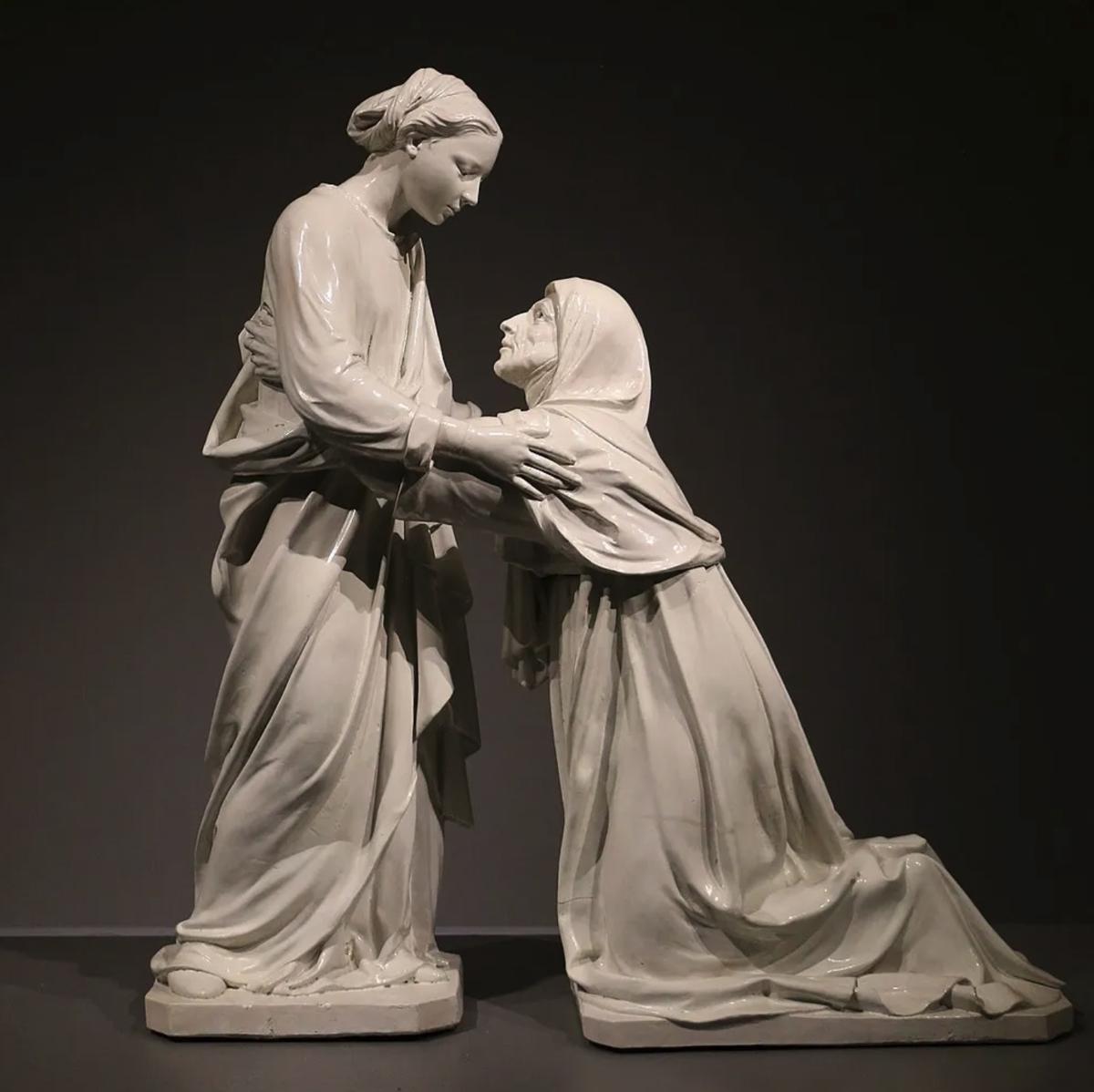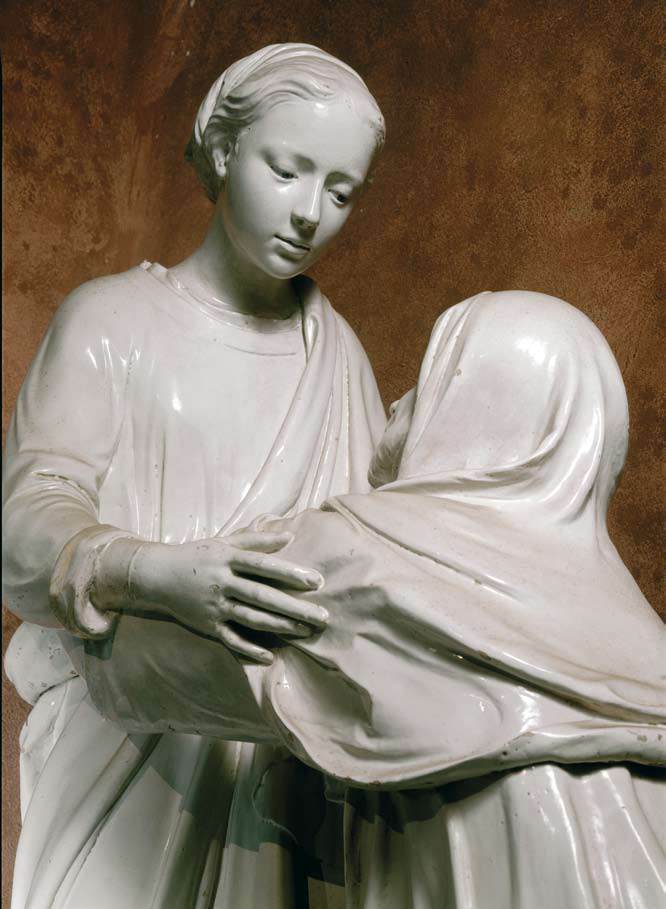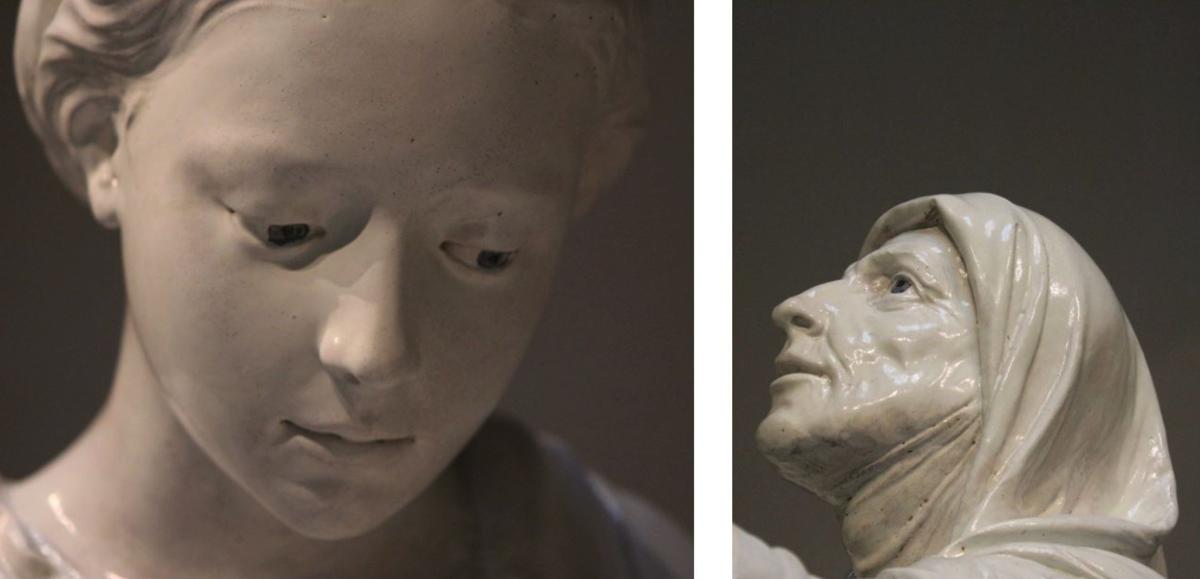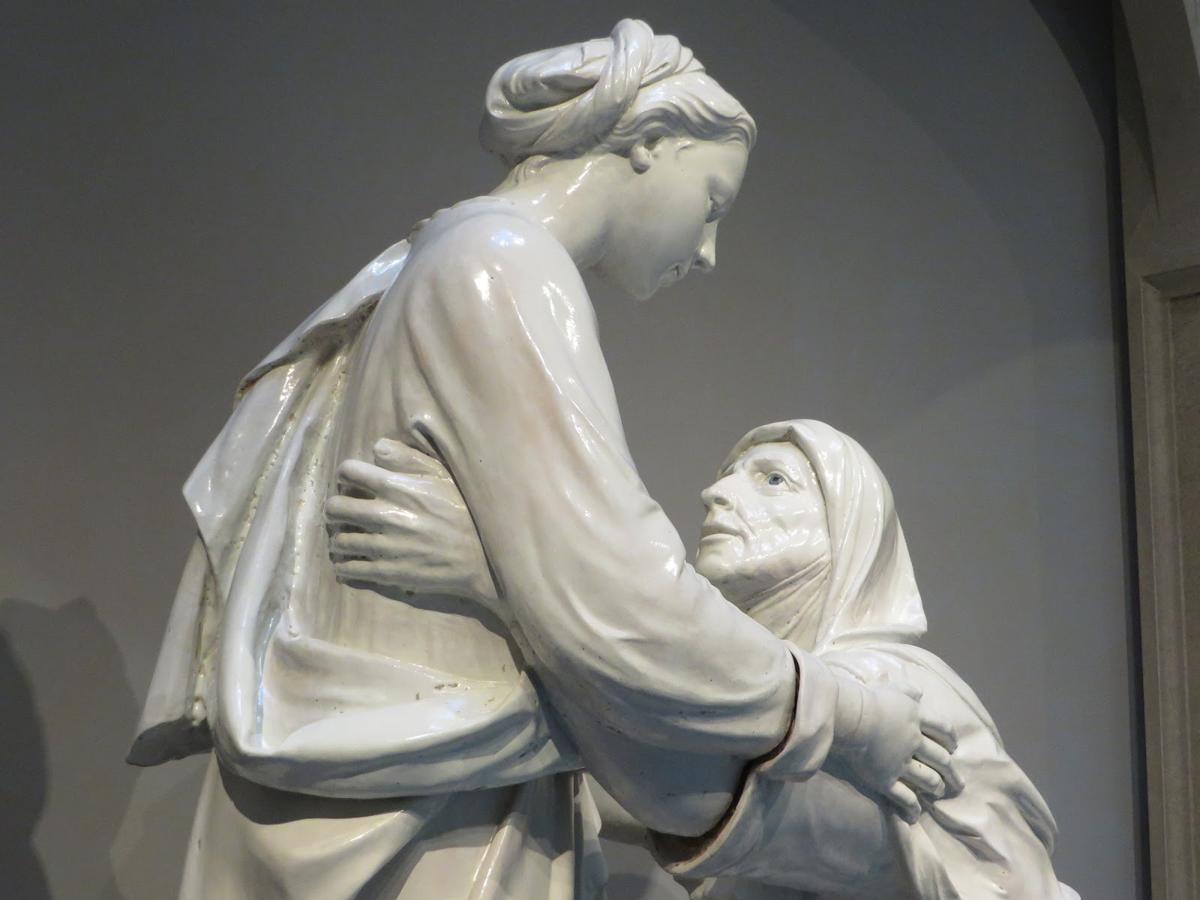December 2: Elizabeth's Song
♫ Music:
Day 5 - Thursday, December 2
Title: ELIZABETH’S SONG
Scripture: Luke 1:39-43
Now Mary arose in those days and went into the hill country with haste, to a city of Judah, and entered the house of Zechariah and greeted Elizabeth. And it happened, when Elizabeth heard the greeting of Mary, that the babe leaped in her womb; and Elizabeth was filled with the Holy Spirit. Then she spoke out with a loud voice and said, “Blessed are you among women, and blessed is the fruit of your womb! But why is this granted to me, that the mother of my Lord should come to me?”
Poetry:
The Visitation
by Malcolm Guite
Here is a meeting made of hidden joys
Of lightenings cloistered in a narrow place,
From quiet hearts the sudden flame of praise,
And in the womb the quickening kick of grace.
Two women on the very edge of things
Unnoticed and unknown to men of power,
But in their flesh the hidden Spirit sings
And in their lives the buds of blessing flower.
And Mary stands with all we call ‘too young,’
Elizabeth with all called ‘past their prime.’
They sing today for all the great unsung
Women who turned eternity to time,
Favoured of heaven, outcast on the earth,
Prophets who bring the best in us to birth.
ELIZABETH’S SONG
Of the New Testament’s Christmas canticles, the first is that of Elizabeth, recorded in Luke 1:39–45. While her husband had been stricken silent and unable to speak for a time (Luke 1:18–23), Elizabeth is not likewise restricted. We comment here on the opening lines of her brief song of praise that bursts forth when she is visited by Mary.
Mary’s interaction with the angel Gabriel, who informs her that she will bear the Savior of the world (!) (Luke 1:26–38), doubtlessly would bring great angst even to a willing and faithful young woman. So, Mary goes “with haste” to visit her relatives Zacharias and Elizabeth. This elderly couple lived in the hill country of Judah outside the city of Jerusalem, where Zacharias served in one of twenty-four priestly divisions that took week-long turns of duty twice a year. Luke had already reported that this elderly couple themselves had earlier received angelic news that they would be having a baby boy. This was surprising given their old age, but less miraculous than a virgin birth! (Luke 1:5–25). Elizabeth was six months pregnant with John the Baptist when Mary arrived (Luke 1:26; and in 1:56) Luke reports that Mary stayed for three months, probably learning quite a bit about childbirth from Elizabeth. It’s when she hears the greeting of Mary, that Elizabeth has a surprising response.
Note the posture of Elizabeth in Luca della Robbia’s sculpture, The Visitation, which portrays Mary’s arrival to visit Elizabeth. Contrary to the first-century Middle Eastern culture where young people would be expected to give deference and honor to those who are older, the elder (and six-months-pregnant) woman Elizabeth is portrayed as willingly bowing before the teenage mother of our Lord. Luke notes that the Holy Spirit provided Elizabeth’s insight into Mary’s motherly condition and mission (Luke 1:41), and Elizabeth willing sets aside social convention, and perhaps personal comfort, and sings out praise in honor of her young relative. One stanza of the Latin lyrics of Franz Beibl’s “Ave Maria” contains the well-known paraphrase of Elizabeth’s praise for Mary: “Hail Mary, full of grace, the Lord is with thee: blessed are you among women, and blessed is the fruit of your womb, Jesus.”
Elizabeth’s Spirit-induced insight is affirmed with a physical leap of the prenatal prophet in her own womb (Luke 1:41). Thus, the Spirit and the body work together within Elizabeth (see Malcolm Guite’s poem, “The Visitation”). And Elizabeth in turn gives her whole self to praise, i.e., “she spoke out with a loud voice” (Luke 1:42). But Elizabeth’s words express not only praise for Mary but also humility regarding herself: “But why is this granted to me, that the mother of my Lord should come to me?” (Luke 1:43). And in her humble praise, we should not miss that there is in Elizabeth’s hymn the not-so-subtle expression of faith that the fruit of Mary’s womb is in fact the Lord of Elizabeth’s life. May the Lord grant us this humble praise and faith.
Prayer:
Dear Lord and Savior, Jesus Christ. Please grant to us by Your Spirit the will and the ability to recognize Your work. Give us humility that matches the insights provided to us that we may counter the expectations of our culture with gracious praise of You in lowly places. And may our faith in You come through in our words and actions.
Amen.
Devotion Author:
Dr. Doug Huffman
Professor of the New Testament
Associate Dean of Biblical & Theological Studies
Talbot School of Theology
Biola University
For more information about the artwork, music, poetry, and devotional writer selected for this day, we have provided resources under the “About” tab located next to the “Devotional” tab.
About the Artwork:
The Visitation (several views)
Luca della Robbia
1440
Glazed terracotta
151 x 148 x 60 cm
Church of San Giovanni Fuorcivitas
Pistoia, Tuscany, Italy
The Luca Della Robbia masterpiece The Visitation presents an intensely moving interaction between Mary, pregnant with Jesus, and her older cousin Elizabeth, who is pregnant with John the Baptist. The sculpture not only captures Mary’s youth, beauty, and purity, but her gesture of respect toward her much-beloved older cousin. This speaks to Mary’s crucial role in salvation, which Elizabeth acknowledges by her submissive gesture toward Mary. Elizabeth on her knees leans forward and wraps her arms around Mary as if acknowledging the great significance of the salvation of the human race—the Savior has come. Even Mary offers her own reassurances by strongly returning the embrace, grabbing onto Elizabeth’s shoulder in a comforting manner. Mary’s face captures both the nobility and greatness of her role, but also her humility through which she magnifies the Lord. These figures are rendered very human, but also exude an unearthly and “elevated” quality due to the shining, brilliant white glaze.
https://buildingcatholicculture.com/reflecting-on-the-visitation-through-art/
https://reconstructingrenaissance.home.blog/2018/12/18/luca-della-robbia-the-visitation-1440/
https://www.artway.eu/content.php?id=2200&lang=en&action=show
About the Artist:
Luca della Robbia (1399/1400–1482) was an Italian sculptor from Florence, Italy. Della Robbia is mostly noted for his colorful tin-glazed terracotta statuary. His large family-run workshop produced both inexpensive works cast from molds in multiple versions and more expensive, unique, individually modeled pieces. Della Robbia's work is noted for its charm as opposed to the drama of the work of some of his contemporaries. His family workshop specialized in depictions of sacred history and devotional images of the Madonna and Christ Child for a variety of settings including altars, chapels within churches, exterior walls and gates, and the domestic realm. The sculptures’ simple materials expressed the spiritual value of humility, exalted by luminous surfaces, while the skill with which they were fashioned and the visual clarity of the medium made them easy to approach and understand. Through pure, expressive color and a refreshing simplicity of means, Della Robbia terracottas illuminated themes of salvation in the Christian faith. Della Robbia sculptures still grace the churches and squares of Florence and other Italian cities, while portable reliefs, statuettes, and busts by the Della Robbia family adorn museums throughout the world.
https://en.wikipedia.org/wiki/Luca_della_Robbia
https://www.nga.gov/features/della-robbia-a-closer-look.html
About the Music:
“Biebl: Ave Maria” from the album Eventide
Lyrics: (Latin)
Angelus Domini nuntiavit Mariae
Et concepit de Spiritu sancto.
Ave Maria, gratia plena, Dominus tecum.
Benedicta tu in mulieribus,
Et benedictus fructus ventris tui, Jesus, Jesus.
Maria dixit: Ecce ancilla Domini.
Fiat mihi secundum verbum tuum.
Ave Maria, gratia plena, Dominus tecum.
Benedicta tu in mulieribus,
Et benedictus fructus ventris tui, Jesus, Jesus.
Et Verbum caro factum est
Et habitavit in nobis.
Ave Maria, gratia plena, Dominus tecum.
Benedicta tu in mulieribus,
Et benedictus fructus ventris tui, Jesus, Jesus.
Sancta Maria, Mater Dei, ora pro nobis peccatoribus,
Sancta Maria, ora pro nobis, nunc et in hora mortis nostrae.
Amen. Amen. Amen.
English Translation:
The Angel of the Lord declared unto Mary
And she conceived of the Holy Ghost.
Hail Mary, full of grace, the Lord is with thee.
Blessed are you among women,
And blessed is the fruit of your womb, Jesus, Jesus.
Mary said: Behold the handmaid of the Lord.
Be it done to me according to your word.
Hail Mary, full of grace, the Lord is with thee.
Blessed are you among women,
And blessed is the fruit of your womb, Jesus, Jesus.
And the Word was made flesh
And he dwelt among us.
Hail Mary, full of grace, the Lord is with thee.
Blessed are you among women,
And blessed is the fruit of your womb, Jesus, Jesus.
Holy Mary, Mother of God, pray for us sinners
Holy Mary, pray for us now and at the hour of our death.
Amen. Amen. Amen
About the Performers:
Formed in 2005, VOCES8, an a cappella octet from the United Kingdom, has a diverse repertoire ranging from early English and European Renaissance choral works to their own original arrangements. The ensemble is dedicated to supporting promising young singers and awards eight annual choral scholarships through the VOCES8 Scholars Initiative, at which amateur singers of all ages are invited to work and perform with the ensemble. VOCES8 tours extensively throughout Europe, North America, and Asia, and their artistic collaborations have included the Philharmonia Orchestra, London Philharmonic Orchestra, period ensemble Les Inventions, violinist Hugo Ticciati, and cellist Matthew Sharp.
http://www.voces8.com/
Lyricist:
The words of the Ave Maria are known as the Angelus Prayer.
About the Composer:
Franz Xaver Biebl (1906–2001) was a German composer of classical music for choral ensembles. He studied composition in Munich. Biebl served as choir director at the Catholic church of St Maria from 1932 until 1939, and as an assistant professor of choral music at the academy of music in Salzburg, Austria. Drafted into the military during World War II, he became a prisoner of war from 1944 to 1946 at Fort Custer in Battle Creek, Michigan. After the war, he moved from Austria to Germany, where he served as director of the town chorus. Biebl’s best known work is his Ave Maria which he composed in 1959. The piece was brought to the United States by the Cornell University Glee Club in 1970, who met Biebel while on tour in Germany. Conductor Thomas A. Sokol was given a number of Biebl's works then, and premiered them after returning home. The "Ave Maria" quickly gained popularity, most notably after becoming part of the repertoire of the vocal ensemble Chanticleer.
https://en.wikipedia.org/wiki/Franz_Biebl
https://en.wikipedia.org/wiki/Franz_Biebl
https://www.pcmsconcerts.org/composer/franz-biebl/
About the Poet:
Malcolm Guite (b. 1957) is a poet, author, Anglican priest, teacher, and singer/songwriter based in Cambridge, England. He has published six collections of poetry: Saying the Names, The Magic Apple Tree, Sounding the Seasons: Poetry for the Christian Year, The Singing Bowl, Waiting on the Word, and the recently released Parable and Paradox: Sonnets on the Sayings of Jesus and Other Poems. Rowan Williams and Luci Shaw have both acclaimed his writing, and his Antiphons appeared in Penguin’s Best Spiritual Writing, 2013. Guite’s theological works include What Do Christians Believe? and Faith, Hope, and Poetry: Theology and the Poetic Imagination. Guite is a scholar of J. R. R. Tolkien, C. S. Lewis, and the British poets, and serves as the Bye-Fellow and chaplain at Girton College at the University of Cambridge, while supervising students in English and theology. He lectures widely in England and the USA, and in 2015 he was the CCCA Visionary-in-Residence at Biola University. Guite plays in the Cambridge rock band Mystery Train and his albums include The Green Man and Dancing Through the Fire.
https://malcolmguite.wordpress.com/
https://en.wikipedia.org/wiki/Malcolm_Guite
About the Devotion Author:
Dr. Doug S. Huffman
Professor of New Testament
Associate Dean of Biblical & Theological Studies
Talbot School of Theology
Biola University
Douglas Huffman (Ph.D. TEDS) has several research interests including New Testament Greek, Luke–Acts, New Testament Use of the Old Testament, and Christian Thought. Author of several books and scholarly articles, Dr. Huffman also serves as a consultant for the streaming TV show, The Chosen, the first-ever, multiple-season television show on the life of Jesus.



